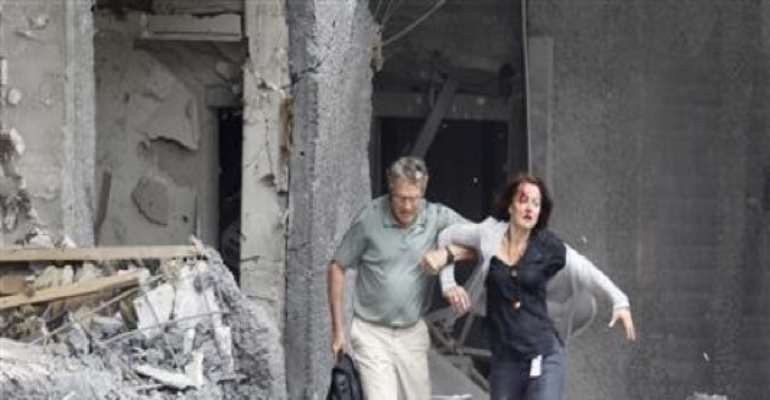Oslo Bomb Kills 7, Gunman Fires On Youth Camp

A bomb ripped through Oslo's central government district on Friday killing seven people, police said, and hours later a gunman opened fire at a youth camp on a nearby island.
One witness said he saw 20 dead at the youth camp, but police said they had no confirmation of deaths on the island.
"I've seen it with my own eyes, at least 20 dead people lying in the water," Andre Skeie, 26, told Reuters by telephone. He said he had gone to Utoeya island with his boat to help people evacuate the island after the shooting.
Police declined to comment on casualties at the youth camp at Utoeya, north west of Oslo. State television said a man was arrested.
The Oslo bomb blew out the windows of the Prime Minister's building, damaged the finance and oil ministries and scattered glass and masonry across the streets.
A Reuters witness said he had seen soldiers taking up positions around the center of the capital, while police said they feared there might be explosives at the youth camp.
With police advising people to evacuate central Oslo, apparently in fear of more attacks, Prime Minister Jens Stoltenberg told Norwegian TV2 television in a phone call that the situation was "very serious". He said that police had told him not to say where he was speaking from.
"It exploded -- it must have been a bomb. People ran in panic...I counted at least 10 injured people," said bystander Kjersti Vedun, who was leaving the area of the blast in Oslo.
Shortly after the bomb, a gunman described by a police official as tall and blond opened fire at the island of Utoeya north-west of Oslo, sending people scattering in terror. The target was a youth camp of Stoltenberg's Labour party youth section.
"There was a lot of shooting...We hid under a bed. It was very terrifying," a young woman present at the island youth camp told British Sky television. She said police helicopters were flying overhead.
Daily newspaper VG said on its website the gunman had been dressed as a policeman.
Norwegian commercial broadcaster TV2 said several people had been killed in the shooting spree.
There was no clear claim of responsibility and while the attacks appeared to bear the hallmarks of an Islamist militant assault, analysts said it was too early to draw any conclusions.
NATO member Norway has been the target of threats before over its involvement in conflicts in Afghanistan and Libya.
The attack came just over a year after three men were arrested on suspicion of having links to al Qaeda and planning to attack targets in Norway. It came also less than three months after U.S. forces killed Osama bin Laden in a raid on his hideout in Pakistan.
Violence or the threat of it has already come to the other Nordic states: a botched bomb attack took place in the Swedish capital Stockholm last December and the bomber was killed.
Denmark has received repeated threats after a newspaper published cartoons of the Prophet Mohammad in late 2005, angering Muslims worldwide.
The Oslo blast tore at the facade of the 17-storey central government building, blowing out most of the windows and scattering shards of metal and other debris for hundreds of meters (yards).
The building of a publisher which recently put out a translation of a Danish book on the Mohammad cartoon controversy was also affected, but was apparently not the target.
The blast scattered debris across the streets and shook the entire city center at around 3:30 p.m. (9:30 a.m. EDT). A Reuters witness saw eight people injured, one covered in a sheet and apparently dead.
MOST VIOLENT "SINCE WORLD WAR TWO"
Madrid suffered an Islamist militant bomb attack on commuter trains in 2004 that killed 191 people. Four suicide bombers killed 52 people in an attack on London's transport system in 2005.
The Reuters correspondent said the streets had been fairly quiet in mid-afternoon on a Friday in high summer, when many Oslo residents take vacation or leave for weekend breaks.
"This is a terror attack. It is the most violent event to strike Norway since World War Two," said Geir Bekkevold, an opposition parliamentarian for the Christian Peoples Party.
The district attacked is the very heart of power in Norway, with several other key administration buildings nearby.
Nearby ministries were also hit by the blast, including the oil ministry, which was on fire. Nevertheless, security is not tight given the lack of violence in the past.
The failed December attack in Stockholm was by a Muslim man who grew up in Sweden but said he had been angered by Sweden's involvement in the NATO-led force in Afghanistan and the Prophet Mohammad cartoons.
That attack was followed weeks later by the arrest in Denmark of five men for allegedly planning to attack the newspaper which first ran the Mohammad cartoons.
In July 2010, Norwegian police arrested three men for an alleged plot to organize at least one attack on Norwegian targets and said they were linked to individuals investigated in the United States and Britain.
John Drake, senior risk consultant at London-based consultancy AKE, said: "It may not be too dissimilar to the terrorist attack in Stockholm in December which saw a car bomb and secondary explosion shortly after in the downtown area.
"That attack was later claimed as a reprisal for Sweden's contribution to the efforts in Afghanistan."
Political violence is virtually unknown in a country known for awarding the Nobel Peace Prize and mediating in conflicts, including in the Middle East and Sri Lanka.
Reuters.
